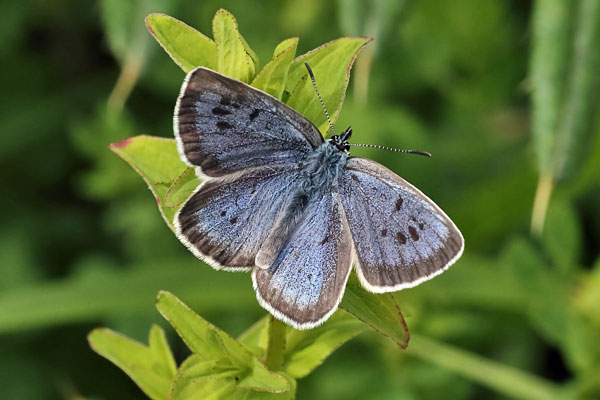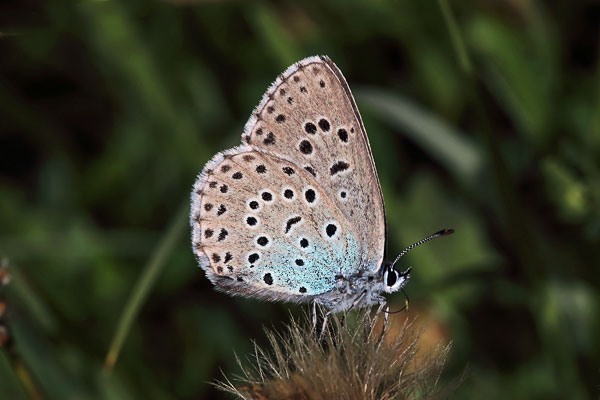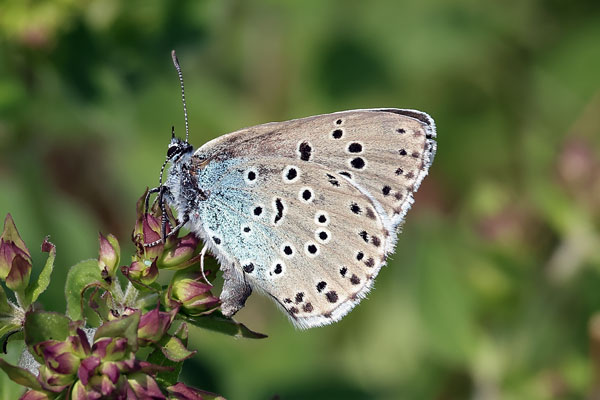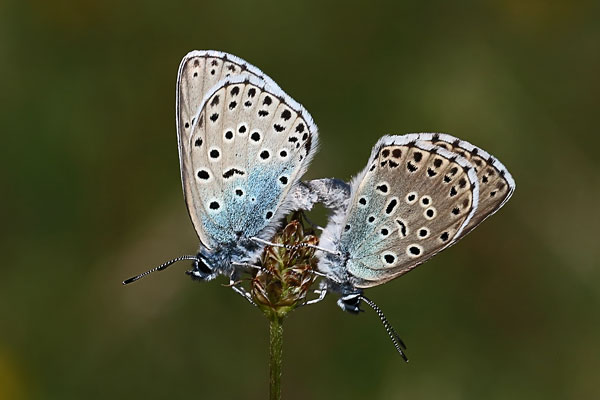Large Blue (Phengaris arion) | Species | ||||||||||||||||||||||||||||||||||||||||||||||||||||||||||||||||||||||||||||||||||||||||||||||||||||||||||||
 Male. Taken at Daneway Banks, Glos., on June 20th 2019. (© David Hastings) (1/800th sec at f14)  Male underside. Taken at Daneway Banks, Glos., on July 16th 2018. (© David Hastings) (1/1000th sec at f14)  Female underside. Taken at Daneway Banks, Glos., on June 16th 2023. (© David Hastings) (1/640th sec at f11)  Mating pair. Taken at Daneway Banks, Glos, on June 15th 2020. (© David Hastings) (1/500th sec at f11) DescriptionFamily: Polyommatinae Wing span: 41 - 50 mm The Large Blue is the largest British blue. Its upper surfaces are the colour of faded denim jeans, with oval forewing spots and wide black borders. The female has larger spots. The underside is greyish-brown with submarginal and marginal black spots on both wings. There is a blue flush at the base of the hindwing. The British subspecies of the Large Blue became extinct in 1979. A similar Swedish subspecies was introduced to a few sites in in the 1980s. It is restricted to a few sites in the Cotswolds and Polden Hills. The Large Blue requires warm, well-drained short grassland, often on limestone. These conditions are needed by the red ant Myrmica sabuleti as well as the Large Blue itself. The female Large Blue will only lay eggs on Wild Thyme (Thymus polytrichus). Upon reaching its fourth instar the larva drops to the ground in the hope of being found by a red ant (Myrmica sabuleti). The ant causes the larva to secrete a droplet from a special gland located on its 7th segment. Eventually, after a period from 30 minutes to 4 hours, the larva distorts its body by rearing up on its prolegs, to give the illusion of being an ant grub. This causes the ant to pick the larva up in its jaws, and carry it back to its nest. Once within the nest, the larva feeds on the ant grubs, which it may do for two years. The larva pupates in the nest, where it continues to be cared for by the ants until it emerges and makes its way to the surface. Adults are usually on the wing from mid-June to mid-July, and only live for about five days. Wild Thyme (Thymus polytrichus) is the only larval foodplant prior to the caterpillars being taken into ant nests. Adults feed primarily on Honeydew and Sap. Bugle, Carline Thistle and Thyme are also used. Males patrol over grassland at the base of slopes, searching for females. They sometimes roost in the shade around mid-day if the weather is hot. Critically Endangered Earliest UK sighting: 14th June ; Latest UK sighting: 8th July Sightings
| |||||||||||||||||||||||||||||||||||||||||||||||||||||||||||||||||||||||||||||||||||||||||||||||||||||||||||||

